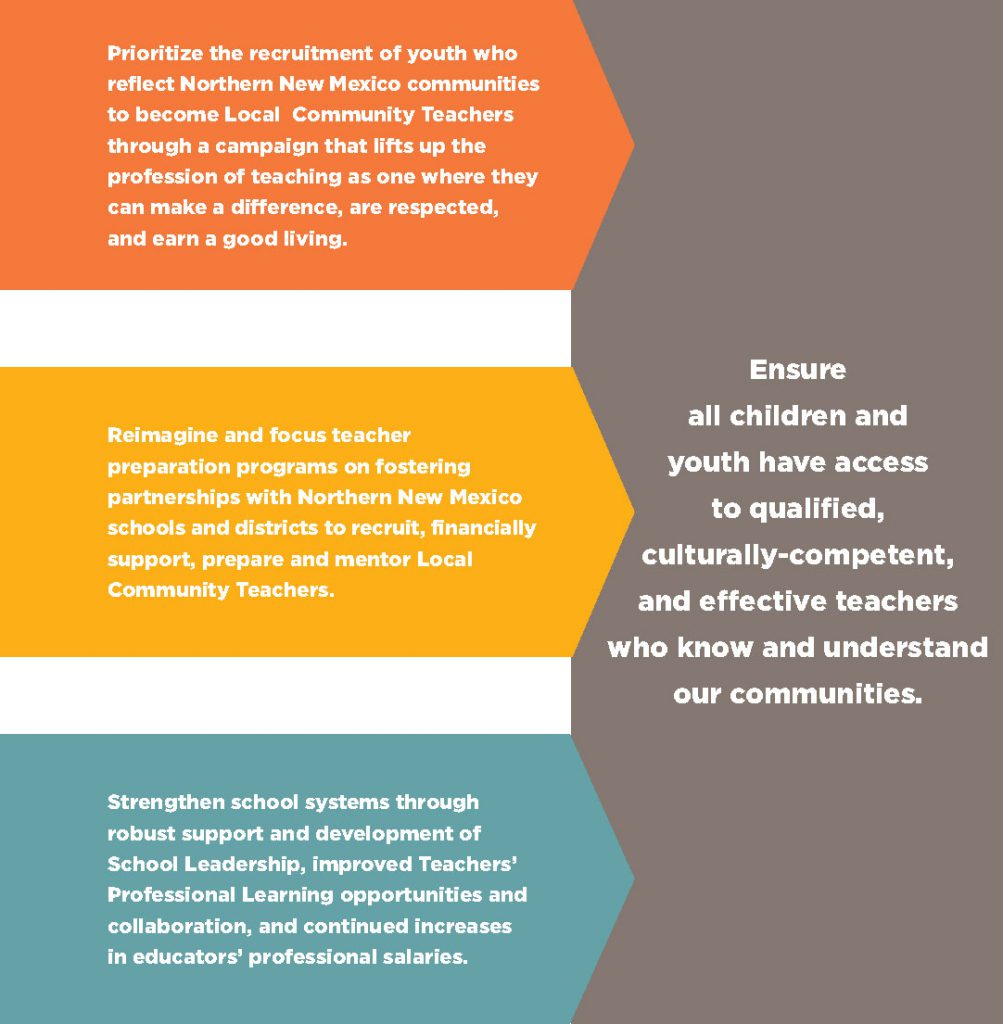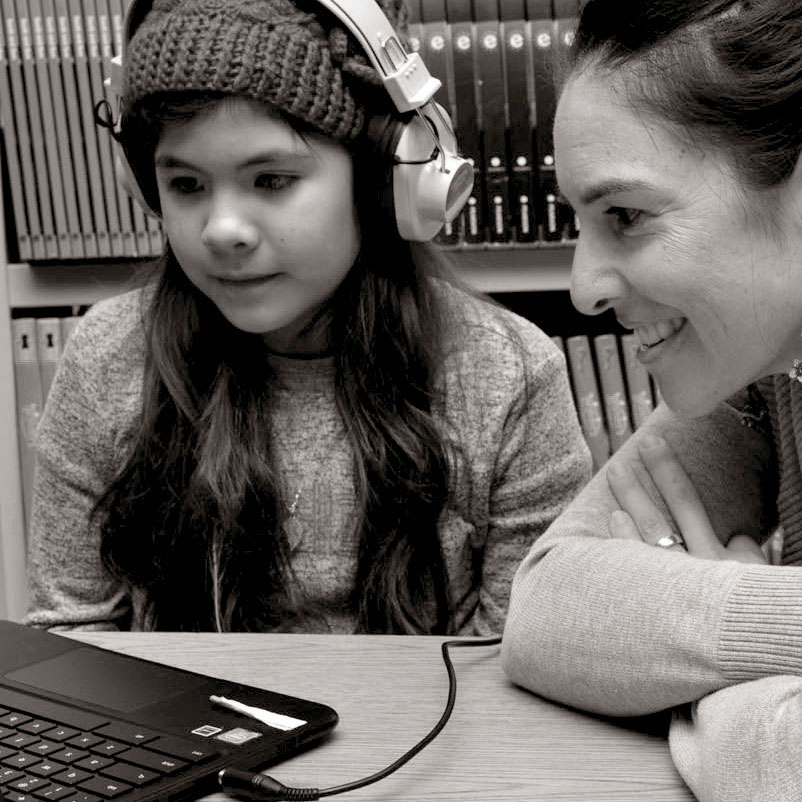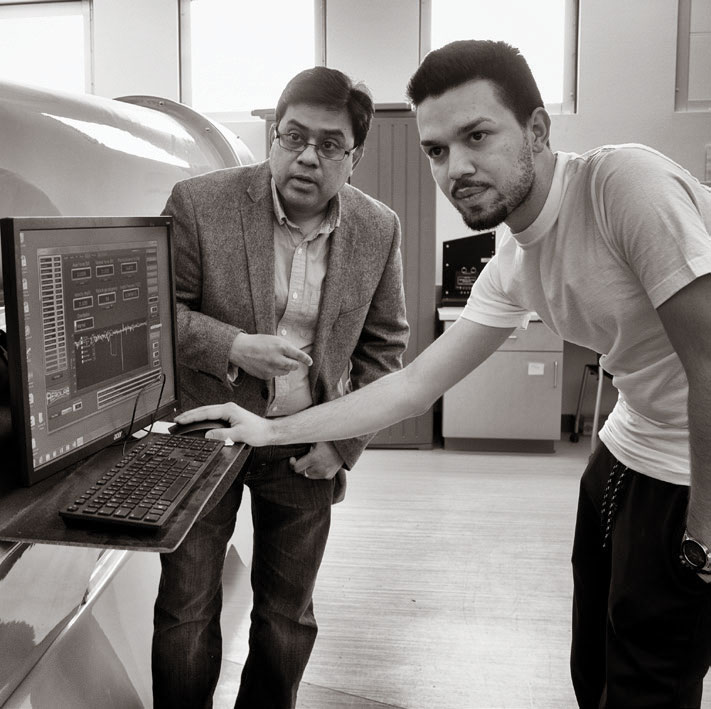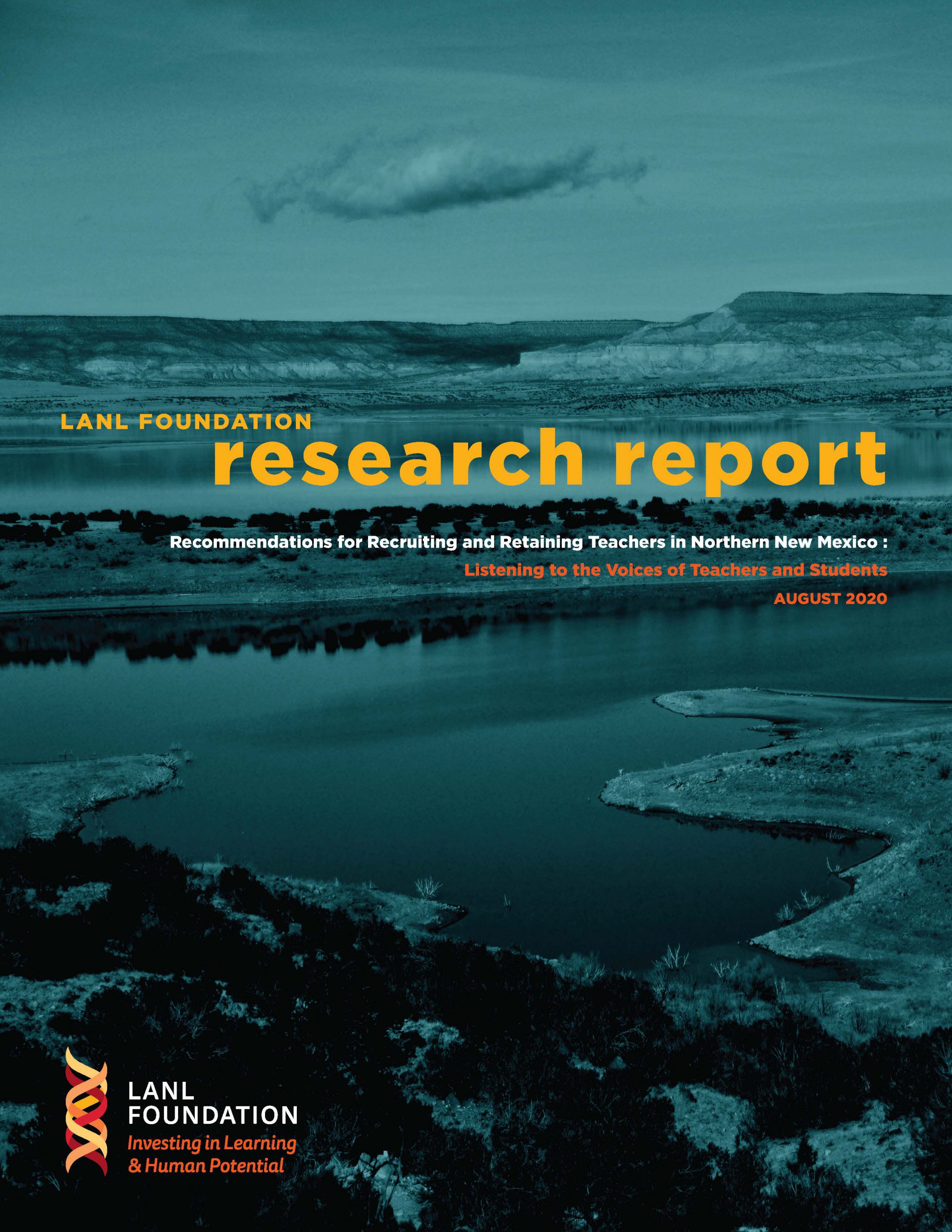
Ongoing shortages of well-qualified and experienced teachers are limiting New Mexico’s ability to improve its education system. Every country and state that exemplifies equitable, high-quality education recognizes the importance of teachers in ensuring children and youth have access to rich and rigorous educational opportunities. Access to qualified, culturally- competent, and effective teachers who know and understand our communities is essential to improving the education system in New Mexico, something our state has recognized since its founding. This policy briefsummarizes the findings of a study LANLFoundation conducted recently with teachers and students in Northern New Mexico tobetter understand the reasons for these shortages. It alsorecommends actions needed to ensure every child in Northern New Mexico has consistent and reliable access to outstanding teachers in each grade and subject area.
In the Fall of 2019, the LANL Foundation in collaboration with Learning Alliance of New Mexico (LANM) investigated the status of teaching in Northern New Mexico. In total, 742 teachers and 565 students participated in surveys or focus groups from 32 districts, charter schools, and Bureau of Indian Education schools within the seven-county region served by the LANL Foundation: Rio Arriba, Taos, Mora, Los Alamos,Sandoval, San Miguel, and Santa Fe. The results demonstrate that teachers care about their students and communities; however, they are frustrated by low salaries and a lack of respect and support for teachers. While 61% of teachers indicated a commitment to the profession and a willingness to encourage their own students to become teachers, almost 30% of teachers – and the majority of novice teachers in the focus groups – have grave concerns about the teaching profession and were hesitant to recruit others into it.
To ensure that every child in New Mexico has access to qualified, culturally-competent, and effective teachers, local and state solutions need to focus on strengthening the profession of teaching. This means continuing to improve teachers’ salaries, while also enhancing their working conditions by improving leadership, school culture, and respect for the profession of teaching. This work is crucial to addressing the findings in the Martinez/Yazzie v State of New Mexico lawsuit, including the need to develop strategies, pedagogies, and systems that are culturally and linguistically relevant and responsive to all students’ assets, needs, and interests. The core recommendations discussed in this brief are summarized in Table 1 below.


“I believe having sufficient and well-trained teachers is critical to the health of our society.“
NORTHERN NEW MEXICO TEACHER
Study Findings

Local Community Teachers Defy Teacher Turnover Trends
Local community teachers, teachers who teach in the communities where they grew up, defy the trends in teacher turnover in New Mexico. Local community teachers live and work in the communities where they grew up at higher rates than non-local teachers. In addition, they stay in the same schools and districts longer than non-local teachers. Notably, 78% of local community teachers earned their bachelor’s degrees from New Mexico colleges and universities, whereas 73% of non-local teachers earned their bachelor’s from out of state institutions. In addition, local community teachers feel better prepared to implement contextual, culturally relevant pedagogies. Several local community teachers spoke about the advantages they have for supporting Native Language learning and healing historical trauma. Local community teachers reported feeling more prepared to teach English language learners and they earn TESOL and Bilingual endorsements at higher rates than non-local teachers. In sum, the study demonstrated that, if recruited and supported, local community teachers from Northern New Mexico are more likely to stay in the region and profession. “I’m from this small community and I feel a lot of respect. I get involved in a lot of activities outside of teaching,” one local community teacher declared.
Teachers are Deeply Committed but Frustrated by Lack of Respect, Low Pay, and School Leadership
The majority of teachers who partici- pated in this study are committed to their profession and to their students but need and want access to on-going professional learning opportunities. In particular, they want differentiated, relevant, on-going professional devel- opment; and opportunities to collab- orate with colleagues, to strengthen the learning opportunities they design. Nineteen percent of beginning teachers reported not receiving mentoring and 50% of all teachers reported not having access to formal professional learning communities. Teachers entering the field through alternative licensure, in particular, feel woefully unprepared for the complex work of being an educator and are more at risk for leaving the profession. Seventy- three percent of alternatively licensed teachers reported they were in the process of completing their teacher preparation program while teaching full-time.
Teachers want more support in their positions. Many teachers in Northern New Mexico report feeling their profession is undervalued and not respected. They are also frustrated with school leadership and low pay. As one teacher said, “It’s a lot of work and in New Mexico, the pay is not great. It’s hard, [I do] not feel valued.” Teachers want to work in a “well-run school with consistent school leadership,” noting the challenges of working in an institution that many teachers felt did not support their work with students. Relatedly, teachers tend to move from school to school with less than half of respondents reporting they have worked at their current school for six years or more. Additionally, teachers’ satisfaction with the profession wanes the longer they are in it. As one teacher described, “The job description is literally being a miracle worker. Government agencies ignore data, such as it taking an ELL around 5-7 years to reach grade-level proficiency, yet expecting a good teacher to do that in a year. I get treated as a defective adult who went to school for numerous years to pick on kids and only teach the ones I like.”
Untapped Potential Among Northern New Mexico Youth
The students in this study demonstrate the untapped potential to increase the recruitment of local community teachers. Twenty-eight percent of students surveyed indicated they had considered becoming a teacher. However, of the 76% of students in this study who plan to attend college only 3% indicated that they were interested in majoring in education. Several obstacles must be addressed so interested Northern New Mexican youth will want to become teachers. Low salaries and low respect for the profession of teaching, along with not having support from their families for becoming teachers, were the primary reasons students cited for not wanting to join the teaching profession. To pursue teaching, students indicated that they would need teacher pay to increase as well as financial support to attend college. The majority of students would also like to see teachers treated better by the system and by their own peers. As one student advised, we need to, “be more inspired to know how being a teacher could be beneficial because most people say teachers don’t get paid well and it’s not worth the time.”

“I’m from this small community and I feel a lot of respect. I get involved in a lot of activities outside of teaching.”
LOCAL COMMUNITY TEACHER
Recommendations for Recruiting and Retaining Teachers in Northern New Mexico
Cultivating outstanding educators who will remain committed to teaching in Northern New Mexico’s schools and communities requires much more adequately meeting the needs of our current teachers, while also strengthening teacher preparation programs in our region, especially when it comes to recruiting and supporting local community teachers. We must also ensure teachers make professional salaries, are valued and respected, and have strong and steady leaders who support their well-being and on-going professional growth in high-functioning schools.



Prioritize Support for Local Community Teachers
Recruiting and supporting youth from throughout Northern New Mexico to become local community teachers – particularly Hispanic/LatinX, Native American, and other students of color – would further ensure the teaching profession in Northern New Mexico is reflective of the people who live in the region and would improve learning opportunities for children in our schools. Sixty-five percent of the students who responded to this survey identified as Hispanic/LatinX and 8% identified as Native American/American Indian. The benefits of more teachers of color in the teaching workforce include enhanced student achievement and graduation rates, students feeling more cared for and academically challenged, and more collegiality and belonging among teachers of color. Also, 38% of student respondents indicated they were bilingual. Recruiting students who are bilingual helps to recognize bilingualism as the asset it is in New Mexico, as defined in the NM Constitution and the NM Bilingual and Multicultural Education Act.
Recommendations to prioritize support for Local Community Teachers include:
- Launch and sustain a statewide campaign to strengthen respect for educators.
- Support the development of local and regional programs to recruit and encourage high school students from Northern New Mexico to gain teaching experience, attend college, and major in education.
- Provide scholarships and stipends that encourage undergraduate and graduate students to return to their home regions to teach after they’ve earned their teaching license as well as stipends to support students through student teaching, and to earn bilingual or TESOL certification.
- Prioritize local community teachers for teaching positions in their home region.
Reimagine and Focus Teacher Preparation Programs
If teacher preparation programs in New Mexico recruit and support students from local communities, it is likely that those students will stay in New Mexico and teach in their communities. In addition, teacher preparation programs and districts will make the most impact on New Mexico school systems by recruiting and financially supporting students from their local communities because these students are more likely to stay in the profession when they become teachers.
Recommendations for reimagining and improving teacher preparation programs:
- Incentivize and support teacher education programs to develop partnerships with schools and districts in Northern New Mexico to recruit, prepare, and retain teachers who are from the region.
- Ensure teacher education programs are grounded in best practices that are culturally and linguistically responsive as well as in the Science of Learning and Development.
- Conduct further research and provide specific supports to alternatively prepared teachers to increase their preparation, persistence, and success, such as differentiated mentoring in their first years.
Strengthen School Leadership, Professional Development and Pay
Teachers in this study emphasized the importance of having strong leadership, feeling supported by their administrators, being compensated appropriately, collaborating with colleagues, and having just-in-time professional development. In Northern New Mexico, the collegiality and expertise teachers share with one another is a strength that can be leveraged. Eighty-eight percent of surveyed teachers indicated that they received support from colleagues. Teacher-led professional development offers opportunities for experienced teachers to grow as leaders while providing colleagues opportunities for professional learning in their home contexts. Specific areas of support surveyed teachers indicated a need for include classroom and student behavior management (33%), working with special populations (31%), and “other areas” (31%).
Recommendations to strengthen school leadership, professional development, collaboration, and pay:
- Increase training and support for principals and superintendents to develop the leadership best practices that will make schools excellent places to work and learn.
- Stay the course and continue to improve educators’ salaries so they are competitive in our region.
- Provide differentiated mentoring for all beginning teachers, recognizing that teachers who are completing alternative licensure programs need different kinds of support than traditionally prepared teachers.
- Ensure teachers have access to meaningful, relevant, in-depth professional learning and collaboration that is responsive to their needs and interests – and that helps teachers to foster their students’ on-going social, emotional, cultural, and academic development.
- Support teachers’ access to Bilingual/TESOL certification, National Board Certification, micro-credentialing, and master’s degrees. Develop structures in the school day that support teachers’ collaboration and on-going professional learning.

“Children have a right to a good school — a good building, good teachers, right time, good activities. This is the right of ALL children.”
MALAGUZZI, AN EARLY LEADER OF THE REGGIO EMILIA APPROACH
Conclusion
Teachers in Northern New Mexico are dedicated to their work with students and they want to work in schools and districts that are well-run, where they feel valued and respected. This includes earning a professional wage, having access to meaningful profes- sional learning, the ability to work collaboratively with colleagues, and having a happy and healthy work environment. A significant percentage of youth in Northern New Mexico could become interested in becoming the teachers we need here, but currently, they see too many obstacles. They do not think they can afford to become teachers and they ask, “How will I pay for student loans on a teacher’s salary?” Students also see teachers as lacking the respect of their peers and the system. This study reveals that many of the teachers who persevere in the profession are those who teach in the communities where they grew up. Thus, recruiting and retaining excellent teachers is a challenge best solved at the local level. Administrators, teacher prepa- ration programs, educators, and community members need to be supported and emboldened to work collaboratively to create the schools and workplaces where local students and local teachers thrive.
About the LANL Foundation
We are a nonprofit, regional philanthropic foundation, and we have been investing in education, learning, and human potential in northern New Mexico since 1997. Through diverse programs and collaboration with key partners, we work to ensure that all New Mexicans have the skills and confidence they need to be self-sufficient lifelong learners who are engaged in their communities. LANL Foundation is based out of Española, New Mexico.
Written by Kersti Tyson, Ph.D., Director of Evaluation and Learning, LANL Foundation; Research by Learning Alliance New Mexico




